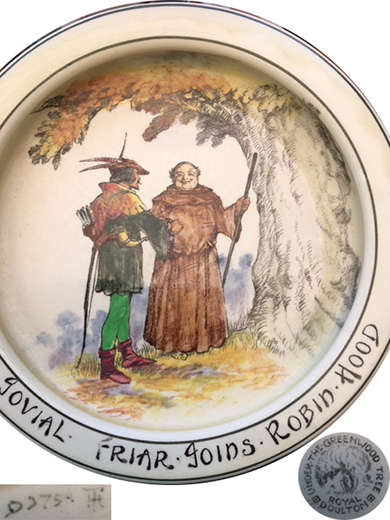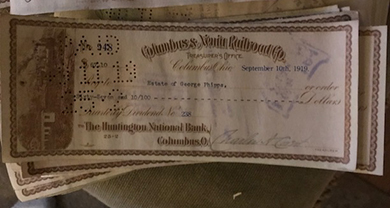 |
|
|||
 |
 |
|||
RINKER ON COLLECTIBLES — Column #1639 Copyright © Harry Rinker, LLC 2018 Questions
and Answers
QUESTION: I have a child’s porridge plate (raised edge dish) with a script text on the edge that reads “THE JOVIAL FRIAR JOINS ROBIN HOOD.” The center shows Robin talking with Friar Tuck beneath a large tree. There are two marks on the back. The first is a text circle with “UNDER THE GREENWOOD TREE” in the top arch and “ROYAL / DOULTON” on the bottom in a reverse arch. The center features a large greenwood tree with Robin standing beneath it. The second mark is a hand painted “D 3751” followed by an interlocking T/H monogram. What information can you provide about my plate? SE, Dunstable, England, Email Question 
ANSWER: Charles Noke, Royal Doulton’s first art director, was instrumental in launching several Royal Doulton Seriesware lines at the end of the nineteenth century. He favored characters and stories drawn from history, folklore, literature, sports, and other sources. Royal Doulton issued the first “Under the Greenwood Tree” series pieces (D3751) in 1914. The series was last made in 1967. During its production, a variety of different form shapes were used. Forms included bowls, chargers, jardinières, dinner plates, tankards, trays, and more. Some pieces had an identification title on the front. Others did not. The identification line varied. For example, your porridge plate reads “THE JOVIAL FRIAR JOINS ROBIN HOOD.” Dinnerware plates with the same scene read: “FRIAR TUCK JOINS ROBIN HOOD.” Doulton kept a log of its “D” numbers. Numbers D3715 to D3821 were issued in 1914. The number only indicates when the design was first used and not when the piece was made. The T/H is the monogram of the artist that hand painted the piece. Although the website Antique Marks (https://antique-marks.com/doulton-artists-marks.html) provides detailed information on Royal Doulton artist marks, I was not able to find a specific artist attribution for the T/H monogram. Although I found more than a hundred listings for pieces from the “Under the Greenwood Tree” series, I did not find your child’s porridge plate. Child’s porridge plates similar in shape to your plate were common in the early to mid-20th century. Your plate most likely dates between 1914 and 1925, making it an early example. Its value is between $25.00 and $35.00 in the United States. The price may be higher in England. QUESTION: I have approximately 500 canceled dividend checks dated between 1919 and the mid-1920s that were issued by the Columbia & Xenia Railroad Company and drawn upon the Huntingdon National Banks of Columbus, Ohio. The checks are signed by Charles A. Covert, the company Treasurer. Each is endorsed. The checks have a railroad engine vignette along one edge. Unfortunately, the cancellation impacts part of the vignette. I inherited these checks from my father’s estate. If they have strong value, I would like to sell them and share the proceeds with my siblings. I would appreciate any information you can provide. – JD, Reading, PA, Email Question 
ANSWER: The Columbia and Xenia Railroad, the first railroad to operate in Columbus, Ohio, was chartered in 1844. In 1853, it reached an agreement with the Little Miami Railroad to operate as one line. In 1868, the Columbia and Xenia Railroad was leased to the Little Miami Railroad who leased it a year later to the Pittsburg, Cincinnati, Chicago and St. Louis Railroad. Eventually, the Pittsburg, Cincinnati, Chicago and St. Louis Railroad became part of the Pennsylvania Railroad. When teaching appraisers, collectors, dealers and others to understand the concept of value, I often show them an object and ask: How many different collectors can you identify that might want to have this object in their collection? Ideally, the answer should never be less than six. In the case of your checks, they appeal to the following collectors—bank; check; check cancellation machine; Columbia and Xenia Railroad; decade/period; Huntingdon Ohio; lithography; Pennsylvania Railroad; and. general railroad. Each of these individuals has a different perceived value of the check. I did not include the autograph collector. Except for Mr. Covert’s ancestors or those of the individuals who endorsed them, autograph interest is nil. One thing is certain, there are not 500 buyers for these checks. The number is more likely between 20 and 25. Hence, putting all 500 checks into the secondary marketplace at one time will flood it, reducing the value of the checks to less than $0.25 each. Also, these checks are regionally focused, meaning their maximum value is in a 100-mile radius of Columbus, Ohio, or more specifically, along the right-of-way of the Columbia and Xenia Railroad. Because of their age and vignette, the checks have a value between $3.50 and $5.00 each. The difficulty is finding someone willing to pay this. My best advice is to take the hoard to a railroad collectors’ show or meet in your area. Sell them to the first dealer who offers you more than $50.00. You can try selling them in packs of 100 for $35.00 dollars. However, after you sell the second pack, word will get around the floor that you are flooding the market and make the sale of the balance extremely difficult. QUESTION: I want to downsize. I have a number of Teenage Mutant Ninja Turtle toys that belonged to my 32-year-old son. What is the current value of a Teenage Mutant Ninja Turtles’ storage trunk? – JEW, Email Question ANSWER: The Teenage Mutant Ninja Turtles arrived on the scene in 1984. By 1986, under the licensing direction of Mark Freedman, the Teenage Ninja Turtles became a mainstream cartoon character sensation. Although still appearing in comics and other media, the Turtles’ Golden Age was the late 1980s through the mid-1990s. The 1980s and the 1990s are the hot decades for 20th century collectibles. The generation that played with the toys is now in their early 30s to early 40s, the time when nostalgia starts to become a value factor. It is possible to search pricing on WorthPoint.com by sale date. This allows tracking the secondary market over time. The following are the most recent sales listed for the Teenage Mutant Ninja Turtles trunk (toy chest): $ 65.00 Feb. 3, 2018 Dismissing the $20.00 price as an anomaly, the following conclusions are possible. First, demand is high. Second, the principle that buying the fourth or fifth example that appears in the marketplace results in lower costs appears to be valid. Third, nostalgia plays a key role. The trunk (toy chest) is not a shelf sitter toy. It takes up space. The buyer has to have room to display it before buying it. Fourth, the secondary market has established a stable price point where sales can occur. Individuals wishing to buy a trunk (toy chest) in very fine or better condition should expect to pay between $60.00 and $70.00. Finally, before you sell your son’s Teenage Mutant Ninja Turtles toys, I recommend you contact him and ask him if he wants them. If he says yes, tell him to come and get them. Providing free storages for grown children’s toys and other possession is not an obligation of parenthood. QUESTION: During a recent visit to Renningers Adamstown Flea Market, I saw a large number of sports collectibles, especially bobblehead dolls Are sports bobbleheads a good long-term investment? – S. Reading, PA ANSWER: The answer is no. The current sports bobblehead craze is the third sports bobblehead collecting craze. The first occurred in the late 1980s and early 1990s and focused on the bobbleheads issued in the 1966-1971 period. In May 1999, the Giants issued the first of the stadium giveaway bobbleheads. Bobbleheads appeared everywhere, causing a second collecting craze. The second craze lasted less than a decade. Things quieted down until 2012 when the Marlins opened its Bobblehead Museum featuring 588 bobbleheads. Within a short period, the bobblehead market exploded. The current market is flooded. Yankee Aaron Judge already has over 25 distinct bobbleheads. Since many are produced as promotional giveaways, their quantity is limited. The result is a highly speculative secondary market. Remember Rinker’s 30-Year Rule—For the first 30 years of anything’s life all its value is speculative. Thirty years from now most of the recently issued bobbleheads will be worthless. The individuals they represent did not have distinguished careers. It is time to introduce Rinker’s Jose Canseco Rule – Nothing is a sure bet. You may not be old enough to remember the speculative pricing associated with the Jose Conseco rookie card. I do. I also remember I was smart enough not to buy one. Harry L. Rinker welcomes questions from readers about
collectibles, those mass-produced items from the twentieth and twenty-first centuries.
Selected letters will be answered in this column.
Harry cannot provide personal answers.
Photos and other material submitted cannot be
returned.
Send your questions to: Rinker on Collectibles, 5955 Mill
Point Court SE, Kentwood, MI 49512.
You also can e-mail your questions to
harrylrinker@aol.com.
Only e-mails containing a full name and mailing address
will be considered.
You can listen
and participate in
WHATCHA GOT?, Harry’s
antiques and collectibles radio call-in show, on Sunday mornings between 8:00 AM
and 10:00 AM Eastern Time.
If you
cannot find it on a station in your area,
WHATCHA GOT?
streams live on the Internet at www.gcnlive.com.
|
||||